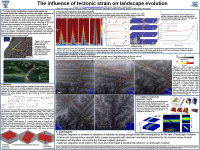CSDMS 2013 annual meeting poster Samuel Roy
The Influence of Tectonic Strain on Landscape Evolution
Abstract:
Tectonic strain localization creates spatially anisotropic mechanical strength patterns that are reflected by landscape. Strain in the frictional-brittle crust produces predictable anisotropic cohesion and grain size distribution fabrics that influence spatial strain induced (SI) erodibility patterns where exposed at the surface. We assume that bedload impact is the primary mechanism for bedrock incision and erodibility is an inverse function of cohesion, which can be reduced by more than 2 orders of magnitude at the meter scale due to fragmentation and grain size reduction. The density, position, and orientation of SI anisotropies depends on the magnitude of strain and the tectonic horizontal/vertical shear stress ratio. The influence of tectonic strain on landscape becomes apparent by incorporating 3D strain induced crustal failure in a landscape evolution model. Natural observations and model results suggest naturally occurring SI anisotropy exerts a first order influence on geomorphic metrics for active orogens, including incision rate, 3D stream network geometry, and topographic evolution. Rates of vertical incision and knickpoint migration are orders of magnitude faster along SI anisotropy exposures. Shallowly dipping faults produced in a dip-slip regime are largely protected from vertical incision by unstrained overburden while a steeply dipping fault produced in a strike-slip regime is largely exposed to vertical incision. The strain field controls hydraulic geometry by influencing 1) the spatial distribution of discharge by establishing anisotropic erodibility patterns and 2) slope changes at erodibility transitions and differential uplift in a watershed. The influence of tectonic strain on landscape increases with the horizontal/vertical shear stress ratio because more steeply dipping and interconnected faults are produced. SI anisotropy controls channel network geometry by amplifying long wavelength tortuosity where fault-bound channels connect and muting short wavelength tortuosity along faults. Both effects increase with increasing tectonic horizontal shear strain. Channel width becomes constricted by the width of SI cohesion reduction, causing channel width to become a function of strain rather than reflecting only the hydraulics of a drainage basin.
* Please acknowledge the original contributors when you are using this material. If there are any copyright issues, please let us know and we will respond as soon as possible.

